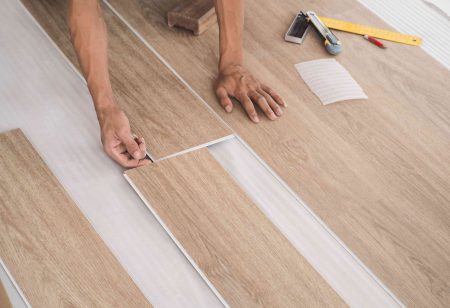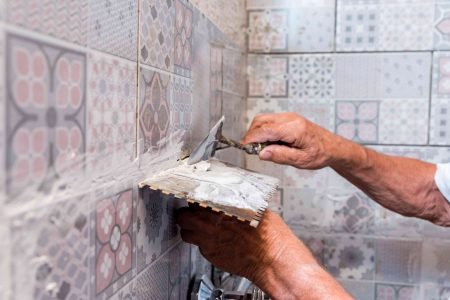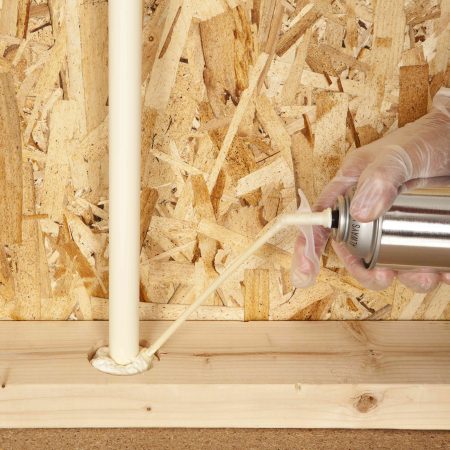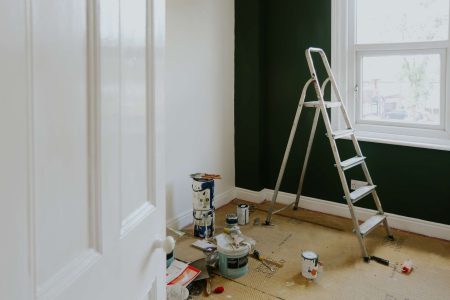A pocket door is a single slab door that slides along an upper header track and when open, the door slab is hidden in an adjacent wall. A pocket door with a rough opening takes up a lot less room than regular interior doors. A 30-inch interior door requires more than 6 square feet of unoccupied swing area. Pocket doors give you just as much privacy and soundproofing—yet they slide invisibly away when not needed.
Installing a pocket door is a one- or two-day intermediate- to advanced-level project if you’re starting with a double-size doorway rough opening. If the door needs to be widened, the project can take several days and may require the assistance of a contractor, especially if the wall is load-bearing.
What Is a Rough Opening?
A rough opening for a pocket door is this: double the door’s width plus an inch. For example, the rough opening for a 36-inch pocket door would be 36 inches + 36 inches + 1 inch = 73 inches wide.
| Rough Opening Measurements for Pocket Doors | |
|---|---|
| Size Pocket Door | Rough Opening Size |
| 26 inches | 53 inches |
| 30 inches | 61 inches |
| 32 inches | 65 inches |
| 36 inches | 73 inches |
How Pocket Doors Work
At the heart of every pocket door installation is a pocket door frame system, also known as a cavity slider. Pocket door frame systems fit into a double-wide doorframe. They act as both the pocket and as the track that carries the door into the opening.
Half of the frame system is the pocket: a hollow wall that holds the door slab when the door is open. This half is sturdy enough to replace the missing wall section. After installation, drywall, trim, and paint are applied to the outside of the pocket. It then blends in with the rest of the wall.
The other half of the frame system is the track. The track continues out of the pocket and across the door header. The slab door hangs from a roller carriage that runs along the track.
Buying a Pocket Door Frame System
Most pocket door systems come fully disassembled in a narrow package of steel, aluminum, or wood pieces. A major part of installing a pocket door is assembling the door frame system, a job that takes two to four hours.
Lower-Cost Door Frame Systems
Inexpensive door frame systems start at around $100 to $200. Typically, these kits are all made of wood, except for the track, fasteners, and a few small parts.
The benefit of these systems is that they are low-cost—a strong advantage since other items, such as the door and drywall, need to be purchased.
On the downside, these lower-cost pocket door frame systems tend to be flexible around the pocket opening. Also, they may have carriages that don’t move as easily as higher-cost systems.
These lower-cost systems will also have as few as two horizontal slats in the pocket area—a weak type of construction that can lead to bowing after the drywall has been installed.
Higher-Cost Door Frame Systems
Higher-cost, higher-quality all-metal door frame systems are sturdy around the lip of the pocket, so they cannot bend as easily as the wood models.
The silicone carriage wheels run on ball bearings for smoother sliding. The tracks often are sturdy enough that they don’t need to be attached to the door header.
They’ll also have more horizontal slats in the pocket area—up to five—for creating a strong wall. These door systems run between $200 and $800.
When to Install a Pocket Door
In new construction or with major remodeling, it’s ideal to install the pocket door during the framing stage. The doorway opening can be sized in advance to the proper width and height.
During a minor remodel, install the pocket door before drywall installation and painting. This allows you to seamlessly merge the pocket door’s drywall and painting work with the rest of the room’s drywall and painting.
Codes and Permitting
Installation of an interior pocket door itself generally will not require a building permit, though it’s best to seek guidance from your local building authority. If the doorframe needs to be widened or altered in any way, a building permit may be required.
Safety Considerations
Turn off circuit breakers to any wall areas that you will be working on. If you need to enlarge the doorframe, make sure that the wall is not load-bearing. If it is load-bearing, you will need to replace sections of the wall with a laminated structural beam.
What You’ll Need
Equipment / Tools
- Cordless drill
- Tape measure
- Bubble level
- Hacksaw or electric miter saw
- Hammer
- Rubber mallet
- Caulking gun
- Pliers
Materials
- Single pocket door frame (cavity slider)
- Door slab, 30-inch by 80-inch
- Drywall
- Drywall screws
- Shims
Instructions
-
Assemble Pocket Door Frame
All pocket door frames assemble differently from one brand to another. Assembling the pocket door frame is a complicated process that takes two to four hours.
- Work on a flat, hard surface.
- Check the pocket section for square by measuring diagonally from end to end. If the two measurements match up, the pocket is square.
- Many pocket door frame systems have adjustable slats. While it’s best to space the slats equally, you can slightly adjust them if needed.
- Off-set the pocket slats so that slats on one side are slightly higher than slats on the other side. This allows for easier access to the back of the slats.
- Many pocket door frames can be cut down to smaller widths. Use a hacksaw or electric miter saw to cut the frame. Be sure to wear hearing and eye protection when cutting.
-
Enlarge Doorframe
- Cut back the doorframe to the correct opening size.
- Remove the drywall.
- Cut out any studs that are not load-bearing.
- Use a saw to cut back the floor plate.
-
Frame Rough Opening
Frame a rough opening, creating a new doorway header and side door jambs.
- The open doorframe should be twice the width of the intended door slab, plus 1 inch. So, the rough opening for a 30-inch door slab should be 61 inches.
- Height should be the vertical length of the door slab, plus the thickness of the door track and desired clearance (about 1 inch, though product dimensions vary).
-
Dryfit Pocket Door Frame
- Lift the pocket door frame and fit it into the door opening.
- Fit the frame’s back stud against the doorframe.
- Check the back stud for plumb with the bubble level.
- Insert shims as needed to plumb the back stud.
- Drive screws through the back stud and through the shims.
-
Add Face Jamb
Attach the pocket door frame’s face jamb to the far end of the doorway (the opposite side of the pocket door frame).
-
Shim Top Track
- Push shims every 24 inches between the top track and the header.
- Check the top track for level.
-
Attach Carriage
Attach the roller carriage to the top track.
-
Attach Hanger Brackets
Screw the hanger brackets into place on top of the slab door.
-
Attach Slab Door
- Attach the slab door to the carriage roller via the hanger brackets.
- Use a wrench to adjust the lock nut to raise or lower the door as needed.
- Hold the bubble level vertically to the side of the door and adjust the lock nuts individually to level the door.
-
Complete Wall
- Hang drywall to the pocket door frame.
- Screw the drywall directly into the pocket door frame slats using drywall screws short enough that they will not penetrate all the way through the pocket slats.
- Tape, mud, and sand the drywall joints.
- Attach trim.
- Finally, paint the wall.
Tips for Installing a Pocket Door
- Make sure that the door frame is perfectly square.
- The header lumber must be straight. Reject any lumber that isn’t straight, as this will make installing the door track much more difficult.
- Don’t forget to add the foam stops to the pocket door frame’s back stud before you add the drywall. These stops help the door open softly. You won’t be able to add the stops after the drywall is in place.
When to Call a Professional
Call a contractor if you need to remove a load-bearing wall. Doors often have light switches and outlets nearby. If you need to move either, call an electrician. Even if you intend to install the pocket door by yourself, it may be helpful to have a carpenter or contractor frame the rough opening for you.
Read the full article here














